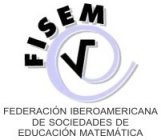Incorporar objetos criados com impressora 3D em atividades em salas de aula de matemática inclusivas
Resumo
In the following writing you will find a didactic proposal, more precisely 3D printing and its competences in the area of mathematics, the week-by-week description of the pedagogical intentions and how knowledge becomes more complex in its progress, the evaluations and the expected performances for the sequence using the Tinkercad software. The learning route for each of the eight weeks is developed, illustrating the key learning ideas to be developed, the expected performances and a brief description of the learning activities. The activities are described, the possible forms of organization of the students, where the questions that generate inquiry processes and their possible answers appear as the way of approaching the problem situation.
Downloads
Referências
Aguilar, G., Torres, M. G. (2021). GeoGebra, impresión 3D y realidad aumentada. Taller presentado en el VIII Taller Internacional “Tendencias en la Educación Matemática Basada en la Investigación en alianza con la Comunidad GeoGebra Latinoamericana”, celebrado del 17 al 20 noviembre de 2021. Libro de Resúmenes, pág. 12-13. https://www.fcfm.buap.mx/TEMBI/files/LibroResumenes_y_Programa-TEMBI8.pdf
Beltrán Pellicer, P.; Rodríguez Jaso, C. (2017). Modelado e impresión en 3D en la enseñanza de las matemáticas: un estudio exploratorio. ReiDoCrea, 6: 16 - 28. http://hdl.handle.net/10481/44193 . ISSN: 2254-5883.
Cobeñas, P.; Grimaldi, V. (2018) Construyendo una educación inclusiva II. Aportes para repensar la enseñanza en escuelas para todos. Asociación Azul.
Educación básica primaria. Ministerio de Educación Nacional Viceministerio de Educación Preescolar, Básica y Media. (2013). Secuencias Didácticas en Matemáticas. Bogotá D.C. – Colombia. ISBN: 978-958-691-546-5 https://www.mineducacion.gov.co/1759/articles329722_archivo_pdf_matematicas_primaria.pdf
Gonzalez-Gomez, J., Valero-Gómez, A., Prieto-Moreno, A., Abderrahim, M. (2012). A New Open Source 3D-Printable Mobile Robotic Platform for Education. In: Rückert, U., Joaquin, S., Felix, W. (eds) Advances in Autonomous Mini Robots. (pp. 49-62). Springer, Berlin, Heidelberg. https://doi.org/10.1007/978-3-642-27482-4_8
Jones, R., Haufe, P., Sells, E., Iravani, P., Olliver, V., Palmer, C., & Bowyer, A. (2011). RepRap – the replicating rapid prototyper. Robotica, 29(1), 177-191. https://doi.org/10.1017/S026357471000069X
Ministerio de Educación, Cultura, Ciencia y Tecnología. (2019). Educación inclusiva: fundamentos y prácticas para la inclusión. 1ª ed. CABA. ISBN: 978-987-47076-5-9. https://www.argentina.gob.ar/sites/default/files/educacion_inclusiva_fundamentos_y_practicas_para_la_inclusion_0.pdf
Secretaria de Evaluación educativa. Ministerio de educación, cultura, ciencia y tecnología. Presidencia de la nación. Autoevaluación aprender. (2019). Educación inclusiva. ISBN: 978-987-784-176-3. https://www.argentina.gob.ar/sites/default/files/educacion_inclusiva.pdf
Direitos de Autor (c) 2023 Mariana Torres

This work is licensed under a Creative Commons Attribution 4.0 International License.
O material publicado na revista é distribuído sob a licença Creative Commons International Attribution 4.0 (CC-BY 4.0). Esta licença permite que outros distribuam, misturem, ajustem e desenvolvam seu trabalho, mesmo para fins comerciais, desde que você seja creditado com a criação original. Os autores das obras publicadas na Revista Unión mantêm seus direitos autorais sem restrições.
##plugins.generic.dates.accepted## 2023-08-19
##plugins.generic.dates.published## 2023-08-31








.png)






